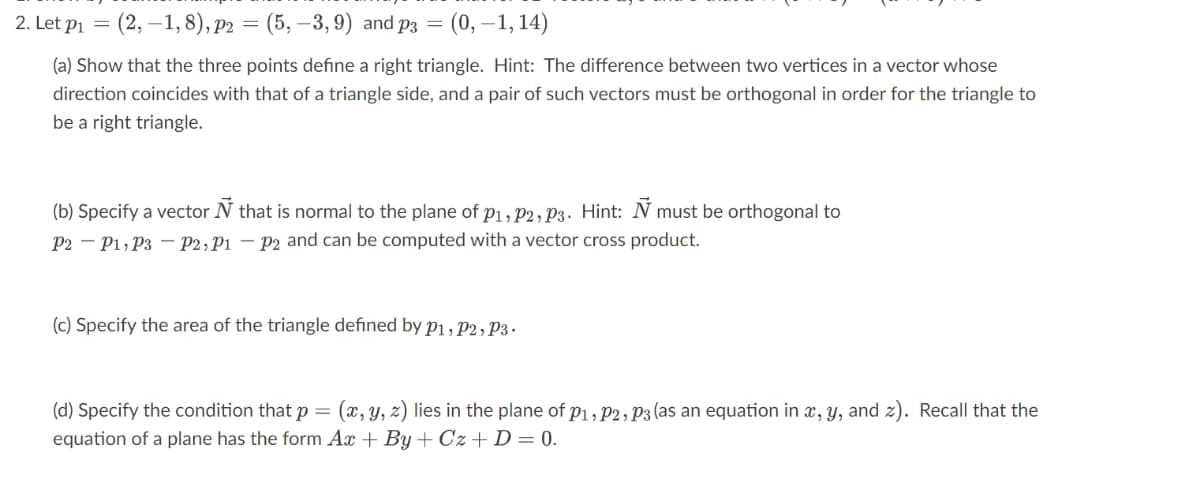2. Let p₁ = (2,-1,8), p2 = =(5, -3,9) and p3 = (0, -1, 14) (a) Show that the three points define a right triangle. Hint: The difference between two vertices in a vector whose direction coincides with that of a triangle side, and a pair of such vectors must be orthogonal in order for the triangle to be a right triangle. (b) Specify a vector N that is normal to the plane of P1, P2, P3. Hint: Ñ must be orthogonal to P2P1, P3 P2, P1 P2 and can be computed with a vector cross product. (c) Specify the area of the triangle defined by P1, P2, P3.
2. Let p₁ = (2,-1,8), p2 = =(5, -3,9) and p3 = (0, -1, 14) (a) Show that the three points define a right triangle. Hint: The difference between two vertices in a vector whose direction coincides with that of a triangle side, and a pair of such vectors must be orthogonal in order for the triangle to be a right triangle. (b) Specify a vector N that is normal to the plane of P1, P2, P3. Hint: Ñ must be orthogonal to P2P1, P3 P2, P1 P2 and can be computed with a vector cross product. (c) Specify the area of the triangle defined by P1, P2, P3.
Linear Algebra: A Modern Introduction
4th Edition
ISBN:9781285463247
Author:David Poole
Publisher:David Poole
Chapter6: Vector Spaces
Section6.6: The Matrix Of A Linear Transformation
Problem 1AEXP
Related questions
Question

Transcribed Image Text:2. Let p₁ = (2,-1,8), p2 = (5,-3,9) and p3
=
(0, -1, 14)
(a) Show that the three points define a right triangle. Hint: The difference between two vertices in a vector whose
direction coincides with that of a triangle side, and a pair of such vectors must be orthogonal in order for the triangle to
be a right triangle.
(b) Specify a vector Ñ that is normal to the plane of P1, P2, P3. Hint: Ñ must be orthogonal to
P2P1, P3 P2, P1 P2 and can be computed with a vector cross product.
(c) Specify the area of the triangle defined by P1, P2, P3.
(d) Specify the condition that p = (x, y, z) lies in the plane of P1, P2, P3 (as an equation in x, y, and z). Recall that the
equation of a plane has the form Ax+By+Cz+ D = 0.
Expert Solution
This question has been solved!
Explore an expertly crafted, step-by-step solution for a thorough understanding of key concepts.
This is a popular solution!
Trending now
This is a popular solution!
Step by step
Solved in 3 steps

Recommended textbooks for you

Linear Algebra: A Modern Introduction
Algebra
ISBN:
9781285463247
Author:
David Poole
Publisher:
Cengage Learning

Elementary Linear Algebra (MindTap Course List)
Algebra
ISBN:
9781305658004
Author:
Ron Larson
Publisher:
Cengage Learning

Algebra and Trigonometry (MindTap Course List)
Algebra
ISBN:
9781305071742
Author:
James Stewart, Lothar Redlin, Saleem Watson
Publisher:
Cengage Learning

Linear Algebra: A Modern Introduction
Algebra
ISBN:
9781285463247
Author:
David Poole
Publisher:
Cengage Learning

Elementary Linear Algebra (MindTap Course List)
Algebra
ISBN:
9781305658004
Author:
Ron Larson
Publisher:
Cengage Learning

Algebra and Trigonometry (MindTap Course List)
Algebra
ISBN:
9781305071742
Author:
James Stewart, Lothar Redlin, Saleem Watson
Publisher:
Cengage Learning

Trigonometry (MindTap Course List)
Trigonometry
ISBN:
9781337278461
Author:
Ron Larson
Publisher:
Cengage Learning

Algebra & Trigonometry with Analytic Geometry
Algebra
ISBN:
9781133382119
Author:
Swokowski
Publisher:
Cengage